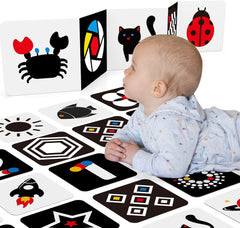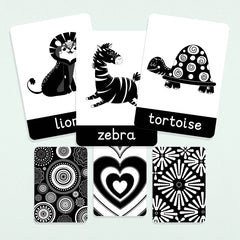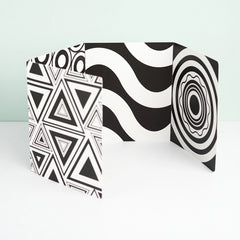Babies are like sponges, eagerly absorbing the world around them through their senses. Baby sensory cards are a fantastic tool for stimulating and nurturing these senses, promoting early development and bonding with parents.
In this blog post, we'll explore, the uses and benefits of sensory cards and provide creative ideas on how to use them to engage your baby's senses and foster their growth. we'll look at:
-
Newborn (0-3 months) - Black and White Sensory Cards
-
3-6 months - Black & white dotted with basic colours Sensory Cards
-
6-12 months - Abstract with various colours Sensory Cards
- 12+ months - Colourful concrete objects with various colours Cards
Black and White Sensory Cards
Newborns ( babies aged 0-3 months) enter the world with limited vision and a preference for high-contrast visuals. This is where black and white sensory cards shine as invaluable tools for early development. Here are some of their uses and benefits in promoting your baby's sensory and cognitive growth during those crucial first few months:
Why Black and White Sensory Cards for Newborns?
- Visual Stimulation: Newborns have an underdeveloped visual system, and they are most responsive to high-contrast patterns, primarily black and white. These bold, contrasting colours are easier for their eyes to detect and focus on.
- Brain Development: The early months of a baby's life are critical for brain development. Black and white sensory cards provide the visual stimulation necessary to activate and strengthen neural pathways, laying the foundation for future visual and cognitive skills.
- Attention-Capturing: High-contrast patterns grab a newborn's attention and keep them engaged. This visual engagement is a stepping stone to improving their ability to focus and concentrate as they grow.
- Tracking Skills: Newborns begin to develop tracking skills by following high-contrast patterns with their eyes. This is a crucial milestone in visual development, as it sets the stage for reading and other visual activities in the future.
Uses and Benefits of Black and White Sensory Cards for Newborns
Visual Development: Black and white sensory cards provide the perfect visual stimulation to help newborn's eyesight mature. These cards encourage them to focus, track objects, and explore their visual surroundings.
Calming and Soothing: The repetitive patterns on black and white sensory cards can have a calming effect on newborns. Gazing at these cards can help reduce fussiness and provide a source of comfort.
Bonding: Interacting with your newborn through sensory cards offers precious bonding moments. Your baby will associate your presence with positive sensory experiences, enhancing the parent-child connection.
Tummy Time: Use black and white sensory cards during tummy time sessions. Placing the cards strategically can motivate your baby to lift their head and develop neck strength, a crucial skill for later motor development.
Enhanced Visual Attention: By presenting different black and white cards to your newborn, you encourage them to shift their gaze and develop more extensive visual attention, preparing them for a wider range of visual experiences.
Stimulating Conversations: Describe the patterns on the cards to your baby. This not only aids their visual development but also introduces them to language and the sound of your voice.
Portability: Black and white sensory cards are lightweight and easy to carry, making them ideal for on-the-go entertainment during car rides or visits to family and friends.
Transition Aid: Sensory cards can help your newborn transition between different activities, providing a moment of visual engagement and distraction when needed.
Fun Activities using Black and White Sensory Cards
Engaging with your newborn using black and white sensory cards can be a delightful and stimulating experience. Here are some fun activities you can enjoy with your baby:
1. Tummy Time Adventures:
Place your baby on their tummy with a black and white sensory card positioned just in front of them. The high-contrast patterns will encourage them to lift their head and engage in tummy time, promoting neck and upper body strength.
As your baby gazes at the card, talk to them about the shapes and patterns. Describe what they see, making it a sensory and language-building activity.
2. Mirror Play:
Set up a small, baby-safe mirror next to a black and white sensory card. Position your baby so they can see themselves in the mirror.
Show your baby the card and then hold it up next to their reflection. This helps them connect the visual stimulus with their own image, promoting self-awareness and recognition.
3. Mobiles and Hanging Cards:
Create a simple mobile by hanging black and white sensory cards from a string or a mobile holder above your baby's crib or playpen.
The gentle movement of the cards and their high-contrast patterns will captivate your baby's attention, providing visual stimulation and entertainment.
4.Sensory Card Book:
Bind several black and white sensory cards together to create a sensory book.
Flip through the pages with your baby, describing each pattern as you go along. This helps build vocabulary and visual recognition skills.
5.Dance and Sing:
Hold a black and white sensory card in front of your face and sing a familiar nursery rhyme or lullaby.
Your baby will be drawn to your face and the card, making it a fun and engaging way to combine visual and auditory stimulation.
6.Texture Exploration:
Attach various textures, such as soft fabric or crinkly paper, to the black and white cards.
Allow your baby to touch and feel the textures while describing them. This sensory exploration enhances their tactile awareness.
7.Peek-a-Boo:
Hold a black and white sensory card in front of your face and play peek-a-boo with your baby.
As you hide and reveal your face with the card, your baby will be delighted by the game and the visual contrast.
8.Sensory Card Discovery:
Place a black and white sensory card under a soft, lightweight cloth or blanket.
Encourage your baby to uncover the card by lifting or pushing the fabric. This activity promotes fine motor skills and visual curiosity.
9.Sibling Interaction:
If you have older children, involve them in the play. Let them show the sensory cards to the newborn and describe the patterns.
This not only helps the baby but also fosters a sense of bonding and responsibility among siblings.
10.Outdoor Exploration:
Take your baby for a stroll in a stroller or a baby carrier and attach a black and white sensory card to the stroller's canopy or your carrier's straps.
The movement and visual stimulation of the card during outdoor walks can be both calming and engaging for your baby.
Remember that newborns have short attention spans, so keep the activities brief and enjoyable. As your baby grows, you can adapt these activities to their changing developmental stages and interests.
Black and white sensory cards are a simple yet powerful tool for supporting your newborn's visual and cognitive development. Their high-contrast patterns stimulate young eyes, promote bonding, and offer numerous benefits during those crucial early months. By incorporating these cards into your daily routine, you can play an active role in nurturing your baby's growing senses and setting them on the path to healthy development. For a twist on Black and white sensory cards, take a look at our Baby Sensory Board.
Exploring the World of Colour: Using Black and White Sensory Cards with Basic Colours for Babies (3-6 Months)
 Babies between the ages of 3 to 6 months are at a fascinating stage of development, gradually transitioning from a black-and-white visual world to a more colourful one. Introducing black and white sensory cards dotted with basic colours like red, yellow, and blue can be a wonderful way to help your baby adjust to seeing colour and enhance their perception of colour and shape. Let's explore the uses and benefits of using these specially designed sensory cards during this critical stage of development.
Babies between the ages of 3 to 6 months are at a fascinating stage of development, gradually transitioning from a black-and-white visual world to a more colourful one. Introducing black and white sensory cards dotted with basic colours like red, yellow, and blue can be a wonderful way to help your baby adjust to seeing colour and enhance their perception of colour and shape. Let's explore the uses and benefits of using these specially designed sensory cards during this critical stage of development.Why Black and White Sensory Cards with Basic Colours?
- Transition to Colour: At around 3 months, a baby's vision begins to develop, and they become more receptive to colours. The use of black and white sensory cards with subtle additions of basic colours helps ease this transition, making the introduction to colour more gradual and less overwhelming.
- Enhancing Visual Discrimination: The combination of black and white patterns with a few basic colours encourages babies to focus on and distinguish between these colours. This promotes visual discrimination skills, which are essential for recognizing and differentiating colours and shapes later on.
- Cognitive Stimulation: The presence of basic colours on sensory cards adds an extra layer of cognitive stimulation. Babies start associating colours with objects and can begin to learn about the world around them through colour cues.
Colour Exploration: Use these cards to introduce your baby to the world of colour. Show them each colour on the card and say its name. Encourage your baby to focus on the colours and observe how they stand out against the black and white background.
Shape Recognition: Alongside colours, sensory cards often feature simple shapes. Point out and describe these shapes to your baby, helping them build early shape recognition skills.
Visual Tracking: Hold a sensory card in front of your baby and slowly move it from side to side. This activity promotes visual tracking as your baby follows the card's movement.
Tummy Time Play: Place the sensory cards strategically during tummy time. The combination of colours and patterns will motivate your baby to lift their head, fostering neck strength and visual engagement.
Sensory Board: Create a sensory board with a variety of sensory cards featuring different colours and patterns. Allow your baby to explore and touch these cards securely attached to a board or wall.
Colour Sorting: As your baby approaches 6 months, you can introduce a simple colour-sorting game. Provide a few objects or toys in red, yellow, and blue, and let your baby match them with the corresponding colors on the sensory cards.
Sensory Playdate: Host a sensory playdate with other parents and their babies. Use the cards to facilitate colour and shape exploration in a social setting.
Language Development: Engage in conversations with your baby about the colours and shapes on the sensory cards. This not only promotes visual awareness but also enhances language development.
Visual Stimulation during Feeding: Use the sensory cards during feeding times to capture your baby's attention and make mealtimes more enjoyable.
Transitional Objects: Sensory cards can serve as transitional objects during changes or transitions. The familiar colours and patterns can provide comfort and distraction.
Incorporating black and white sensory cards with basic colours into your baby's daily routine can be an enjoyable and educational experience. It helps them adjust to the colourful world around them while nurturing their cognitive and visual development in a gentle and engaging manner



